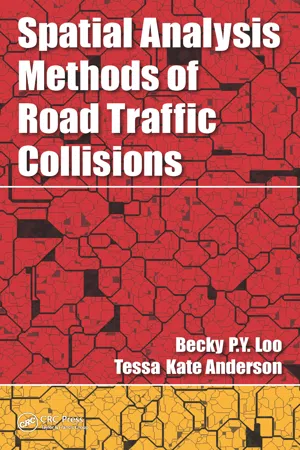
This is a test
- 346 pages
- English
- ePUB (mobile friendly)
- Available on iOS & Android
eBook - ePub
Spatial Analysis Methods of Road Traffic Collisions
Book details
Book preview
Table of contents
Citations
About This Book
Examine the Prevalence and Geography of Road CollisionsSpatial Analysis Methods of Road Traffic Collisions centers on the geographical nature of road crashes, and uses spatial methods to provide a greater understanding of the patterns and processes that cause them. Written by internationally known experts in the field of transport geography, the bo
Frequently asked questions
At the moment all of our mobile-responsive ePub books are available to download via the app. Most of our PDFs are also available to download and we're working on making the final remaining ones downloadable now. Learn more here.
Both plans give you full access to the library and all of Perlego’s features. The only differences are the price and subscription period: With the annual plan you’ll save around 30% compared to 12 months on the monthly plan.
We are an online textbook subscription service, where you can get access to an entire online library for less than the price of a single book per month. With over 1 million books across 1000+ topics, we’ve got you covered! Learn more here.
Look out for the read-aloud symbol on your next book to see if you can listen to it. The read-aloud tool reads text aloud for you, highlighting the text as it is being read. You can pause it, speed it up and slow it down. Learn more here.
Yes, you can access Spatial Analysis Methods of Road Traffic Collisions by Becky P. Y. Loo, Tessa Kate Anderson in PDF and/or ePUB format, as well as other popular books in Matemáticas & Probabilidad y estadística. We have over one million books available in our catalogue for you to explore.
Information
Chapter 1
Collisions as Spatial Events
1.1 Introduction
Throughout the world hundreds of millions of motor vehicles mix with billions of people. A pedestrian crossing a busy street tries to make eye contact with the approaching motorist. Will he slow down? The motorist tries to divine the intentions of the pedestrian. Will he give way? Shall I? Shan’t I? Will he? Won’t he? As the distance between them closes, signals implicit and explicit pass between them at the speed of light. Risk is perceived as risk acted upon. It changes in the twinkling of an eye as eye lights upon it.
Adams (1995)
The analysis of road traffic collisions is not easy, due to their complexity. The American Automobile Association estimates that road traffic collisions claim a life every 13 min in the United States, and the World Health Organization (WHO) estimates 1.18 million people were killed in 2002 in road collisions, which was 2.1% of the global mortality (Peden et al. 2004). Road traffic collisions have been considered by the WHO to be the leading injury-related cause of death among people aged 15–44. Road traffic collisions have formed part of our everyday lives. Every person is at risk. Even if one is not a vehicle driver, one is likely to be a pedestrian, a passenger, and/or a cyclist, and at some point every person is subject to using the road network and, therefore, be at risk of being involved in a road traffic collision.
There are two main approaches to road safety and road collision reduction. The first of these is preventing the collision itself. The second approach to road safety can be determined by the need to reduce the damage that occurs in a collision. Critics have labeled this approach “safe collision,” and some argue that this approach has been overemphasized by government policies and traffic safety agencies alike (Gladwell 2001). However, the backbone of any collision analysis is the datum and its quality. There has been an increasing interest over the recent years on the management, collection, and analysis of data related to road collisions.
It has often been said by road safety professionals that data, together with their analysis, are the cornerstone of all road safety activities. Good-quality data are ultimately essential for the diagnosis of the road collision problem and the reduction or management of road collisions. It is important to identify what categories of road users are involved in collisions, what maneuvers and behavior patterns lead to collisions, and under what conditions collisions occur, in order to define appropriate safety measures. The analysis of road collisions varies considerably, and there are neither bespoke universal guidelines of how road traffic collisions should be analyzed nor best practice guides on prediction and prevention for practitioners and academics alike. For instance, within London, although all boroughs are managed and ...
Table of contents
- Preface
- Authors
- Abbreviations
- Chapter 1 - Collisions as Spatial Events
- Chapter 2 - Collision Density in Two-Dimensional Space
- Chapter 3 - Road Safety as a Public Health Issue
- Chapter 4 - Risk and Socioeconomic Factors
- Chapter 5 - Road Collisions and Risk-Taking Behaviors
- Chapter 6 - Road Collisions and Urban Development
- Chapter 7 - Nature of Spatial Data, Accuracy, and Validation
- Chapter 8 - Collisions in Networks
- Chapter 9 - Cluster Identifications in Networks
- Chapter 10 - Exposure Factor 1: Traffic Volume
- Chapter 11 - Exposure Factor 2: Road Environment
- Chapter 12 - Exposure Factor 3: Distance Traveled
- Chapter 13 - Enforcement
- Chapter 14 - Engineering
- Chapter 15 - Education
- Chapter 16 - Road Safety Strategy
- Appendix: STATS19 Data Record Sheets